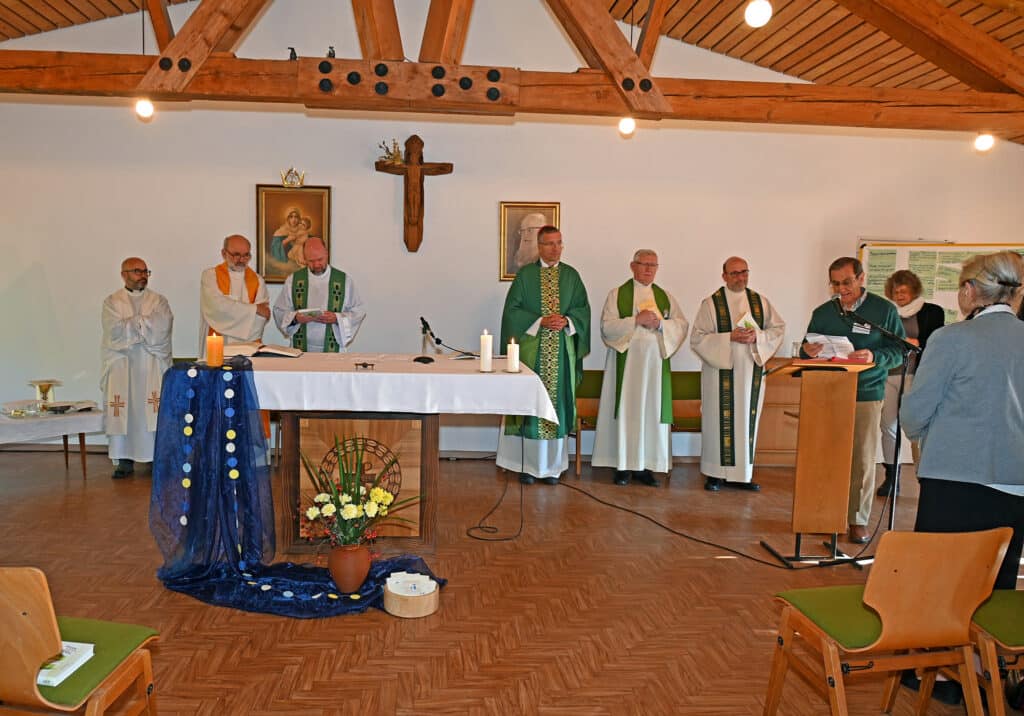Familien in den Schönstatt-Familienbund hinein zu begleiten, wie Josef Kentenich Menschen seit 1914 in Schönstatt hinein begleitet hat, wie geht das? Dieser Frage stellte sich ein europäischer Kongress, der vom 31. Oktober bis 3. November auf dem Josef-Kentenich-Hof in Hillscheid stattfand. Aus neun europäischen Ländern, in denen es den Schönstatt-Familienbund gibt, waren etwa 80 Personen, neben den Ehepaaren auch Schönstattpatres und Marienschwestern, gekommen, die sich in solchen Begleitungsvorgängen engagieren.
Viele der Paare sind in ihren Territorien als Begleitfamilien für Kandidaten-Kurse tätig, andere tragen in der Leitung Verantwortung für die Kandidaten. Die Schönstattpatres und Marienschwestern, aber auch zwei der Paare, bauen als Gründungsbeauftragte in ihrem Arbeitsgebiet den Familienbund mit auf. Ebenfalls anwesend waren die vier Ehepaare der Leitung des internationalen Schönstatt-Familienbundes aus Argentinien, Paraguay, Deutschland und Österreich. Für den amerikanischen Kontinent gab es bereits im Februar in Costa Rica ein sogenanntes „Begleitfamilientreffen“, sodass in diesem Jahr alle Territorien des Familienbundes die Gelegenheit zu diesem Austausch hatten.
Dank eines motivierten internationalen Helferteams und vor allem dank der Mitwirkung von sieben Übersetzerinnen und Übersetzern aus vier verschiedenen Schönstattgemeinschaften, die eine Simultanübersetzung in mehrere europäische Sprachen ermöglichten, war im Josef-Kentenich-Hof ein intensives Arbeitstreffen mit Impulsen und wechselnden Arbeitsgruppen mit viel Zeit zum Austausch und in schöner Atmosphäre möglich.

Begleitung, eine komplexe Aufgabe, die viele Fragen berührt
Die Begleitung junger Familien in die Gemeinschaft des Schönstatt-Familienbundes hinein wurde als komplexe Aufgabe beschrieben, bei der viele Fragen auftauchen:
Wie können die Situation, die Anliegen, die Probleme und die Bedürfnisse von jungen Familien bei den ersten Tagungen, Treffen und Gruppenstunden der Kandidatenkurse ernst genommen und aufgegriffen werden? Wie kann die gemeinsame Zeit so gestaltet werden, dass sie gewinnbringend für das Paar, die Kinder und die Kursgemeinschaft wird? Wie können Sehnsüchte, die bei den Paaren wahrnehmbar sind, vom Begleitteam aufgegriffen und aus der Spiritualität Schönstatts heraus beantwortet werden? Wie können die Kandidatinnen und Kandidaten bei der Suche nach ihrem „Persönlichen Ideal“, ihrem „Eheideal“ und die Kurse bei der Suche nach ihren „Kursidealen“ unterstütz werden? Und schließlich: Wie kann die Gemeinschaft den anspruchsvollen Dienst der Begleitfamilien unterstützen?

Begleitung, Begegnung und Bindung ermöglichen Wachstum
Das Bild einer Schatztruhe beschreibt den pädagogischen Vorgang: Ausgehend von den Fragen und Sehnsüchten der jungen Familien greifen die Begleitfamilien sowie die geistlichen Assistenten und begleitenden Marienschwestern in die Schatztruhe der schönstättischen Spiritualität und bieten diese Erziehungsmittel, Lebensvorgänge und auch das dazu nötige Wissen den Kandidaten an.
Weil also ohne „fortlaufenden Lehrplan“ alle zentralen Themen, die die Gemeinschaft ausmachen, im Laufe der Kandidatur besprochen werden, sodass inneres Wachstum geschehen kann, ist diese Methodik anspruchsvoll: Ihre Voraussetzung ist die Öffnung und Gestaltung eines Resonanzraumes, der es jeder Person des Kurses erlaubt, sich frei und in einer vertrauensvollen Atmosphäre äußern zu können.
Die Teilnehmenden der Tagung waren sich darüber einig, dass es dafür vor allem gute gegenseitige Beziehungen benötigt. Pater Kentenich habe den ihm anvertrauten Jungen, die er als Spiritual begleitet habe, angeboten, sie mit all seinem Können und Nichtkönnen, seinem Wissen und Nichtwissen, zu begleiten, „vor allem aber mein Herz“ zur Verfügung zu stellen. In dieser Haltung, so waren die anwesenden Ehepaare sich einig, kann Begleitung glücken, Begegnung und Bindung geschehen und Wachstum gelingen.

Vernetzung und gemeinsame internationale Weiterarbeit
Mehrere Begleitehepaare aus verschiedenen Ländern brachten sowohl zu umfassenden Themen wie auch zu ganz praktischen und konkreten Fragestellungen Impulse ein, die im fruchtbaren Austausch in Arbeitsgruppen weiterbesprochen wurden. In einer geschwisterlichen, synodalen Atmosphäre wuchs die Vernetzung untereinander und es entstanden Ideen, wie auf europäischer Ebene gemeinsam weitergearbeitet werden könnte.
Zum Programm gehörten auch gemeinsame Gebetszeiten, Eucharistiefeiern und ein fröhlicher Festabend sowie eine Lichtfeier am Allerseelentag, bei der die Teilnehmenden Kerzen zu den „Heldengräbern“ am Urheiligtum brachten und dort der Verstorbenen aus der ersten Schönstattgeneration, aus dem Schönstatt-Familienbund und aus ihren Familien gedachten. Bei einem Besuch in der Gründerkapelle erneuerten die Teilnehmenden ihre Verbindung mit Pater Josef Kentenich.
Den Festgottesdienst zum Abschluss der Tagung feierte Bischof Dr. Michael Gerber, Fulda, der selbst in einer Schönstatt-Bundesfamilie aufgewachsen ist. Er nahm in seiner Predigt Bezug zur Synode über die Synodalität, die eine Woche zuvor zu Ende gegangen war, und erinnerte daran, dass jede Familie eine Hauskirche sei, in der die Zukunft der Kirche gestaltet werde.
Eine nachhaltige weitere Zusammenarbeit in vielen möglichen Formaten wird die Verbundenheit und den gegenseitigen Austausch unter den Begleitfamilien der verschiedenen Territorien in Zukunft sichern.
Quelle: schoenstatt.de
